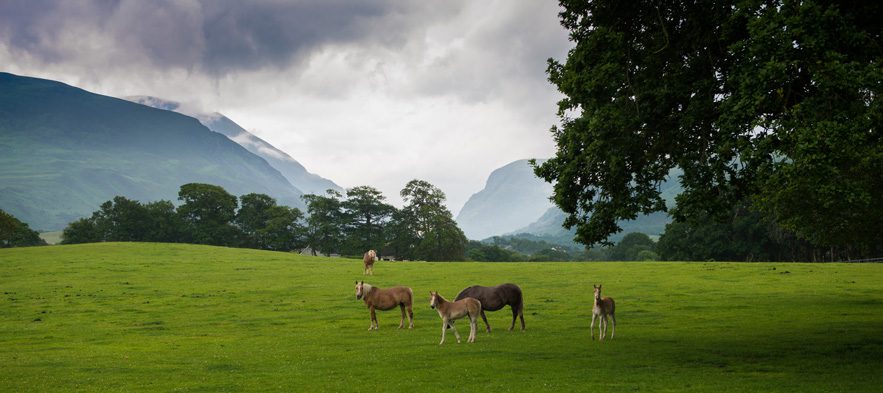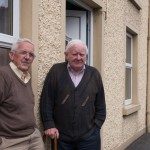
Every year, Tulsa’s Honors Orchestra ventures to a new part of the world, and the only criteria is that the adventure take the orchestra to a place rich in musical history. Members of the orchestra have explored the tunes of Italy, Austria, Germany and Argentina. For a second time, the orchestra recently landed on the small island off the western coast of Great Britain: Ireland.
Photographer Nathan Harmon tagged along with his wife, Karen, and daughter, Lexy, to capture the imagery the trip offered. Karen, director of Tulsa’s Honors Orchestra and organizer of their yearly trips, learned everything from her mother, who started the Orchestra 35 years ago.
On this adventure, students between the ages of 7 and 25 traveled some 1,200 miles, by bus, across Ireland’s green landscape. They visited churches, famous cafés and restaurants, castles, farms and, of course, for those of age, pubs.
“It was a great chance to make sure Guinness was still making [its beer] right,” Harmon says, agreeing with the popular belief that Guinness tastes different in Ireland.
“They don’t pasteurize it like we do in the United States. They simply write the date it was made on the keg, and by the time that date comes around it better be empty because it will get thrown away either way,” he says.
The group touched down in Ireland at the Dublin Airport and spent the next nine days enjoying the food, scenery, music and history that Ireland has to offer, with stops in Waterford, Killarney, Co. Kerry, Galway and County Meath.
Welcome to Ireland
Upon the group’s arrival to Dublin, they met with a local guide for a Panoramic City Tour, which would introduce them to the principal sites the city has to offer: elegant Georgian squares, Trinity College, St. Patrick’s Cathedral (Ireland’s largest cathedral), Christ Church Cathedral and The Guinness Storehouse. The orchestra would delve deeper into these sites’ histories when they’d return to Dublin on the last leg of their trip.

From Dublin to Waterford
On the group’s second day in Ireland, after a full Irish breakfast, many times including bacon, sausages, black and white puddings, eggs, vegetables and potatoes all fried in creamery butter with homemade Irish soda or brown bread for soakage, the group departed to Waterford. On their way, they made a quick pit-stop in Kilkenny to see the famous Kilkenny Castle.
Built by the Anglo-Normans in the 12th century, the castle stood tall and strong as the orchestra toured its grounds and renovated interior. Afterward, the group boarded the bus and traveled south to Waterford, Ireland’s oldest city.
After reaching Waterford, “By hook or by crook,” – a slogan coined by Henry II when searching for the city in 1170 – the group took a walking tour with a local guide. They sneaked through Waterford’s narrow alleyways that jet off its larger streets exploring the still present Viking culture that has survived the centuries. The group ventured to Reginald’s Tower, Ireland’s oldest civic building and part of the historic Viking Triangle, as well as the French Church.
Before leaving Waterford, the Orchestra toured the Waterford Crystal Visitor Centre, where they walked through the factory getting an up-close view of the centuries-old tradition of making Waterford Crystal. Blazing furnaces and wooden mold-making and crystal blowing production areas filled the space that creates the world’s most famous crystal.
Scroll left and right to see more photos in the gallery.
Waterford to Killarney
As the orchestra watched Waterford fade in the distance, the bus drove onward toward Blarney Castle, one of Ireland’s oldest and most historic castles situated in Blarney Village, just outside Cork City.
Here, the group joined tourists from all over the world in kissing the stone the castle is made of.
“It’s a tourist trap,” says Harmon. “We had to [kiss the stone].”
The current standing castle, built in 1446, is famous for its Blarney stone, The Stone of Eloquence. The legend says that the stone has the power to bestow the gift of eloquence on all those who kiss it. And that’s just what they did.
The route to Killarney ventured onto the Iveragh Peninsula, also known as the Ring of Kerry, where they enjoyed the most panaramic drive in Ireland: beautiful mountains, bogs, lakes and views of the Atlantic ocean stretch the 166 kilometer, roughly 103 mile, route.

Kerry to Galway
Traveling up to Galway, the group crossed River Shannon by ferry continuing to the Cliffs of Moher, whose sheer face dips 213 meters down into the waters of the Atlantic. Farther north, they entered the Burren Regions, famous for its limestone pavements, which have, over the years, eroded into a distinctive pattern.
Once in Galway, the group enjoyed dinner, music and entertainment at Padraicins Seafood Restaurant. Later, they visited the Connemara region. Made up mostly of the Twelve Bens mountain range, this region’s position on the Atlantic coastline also welcomes many creeks, bays and harbors for sightseers to indulge in.
Back to Dublin
As the group headed back to Dublin, they stopped by Rathbaun Farm, where the Connolly family farms its 80 acres. Sheep, cows and horses inhabit the land. Time spent here gave students a glimpse into the daily workings of an Ireland sheep farm.
Arriving in Dublin later that night, the group would wake the next morning to explore the famous, Gothic style St. Patrick’s Cathedral. One of the few buildings left from Medievel Dublin, the present structure was built in 1220. They also toured The Guinness Storehouse, Europe’s largest stout producing brewery, and its seventh-floor Gravity bar where they could sample “first-hand, the elixir of life – a pint of Guinness,” as the orchestra’s itinerary described it. To cap off the day, a dinner at Merry Ploughboy Pub awaited the group. The nightly shows are “undoubtedly the must-do Irish music experience on any Dublin trip,” the group’s itinerary also mentioned.

Farewell to Ireland
The day of departure, the group said goodbye to Ireland in the only way they saw fit – a final Irish breakfast.
Tulsa’s Honors Orchestra’s next stop? Quebec City, Canada.
































